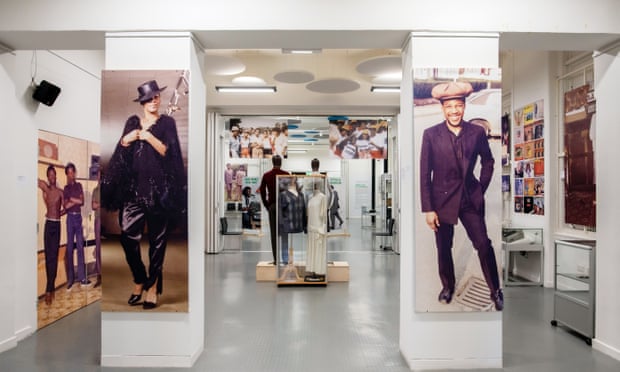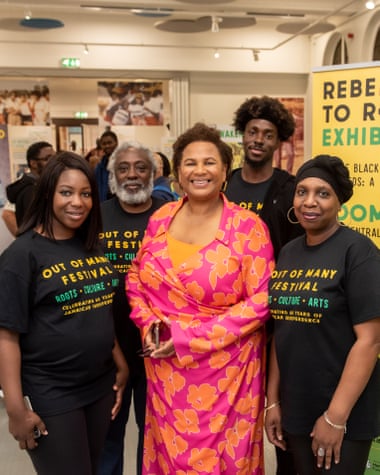When considering Britain’s Windrush legacy, most people may think of London. The majority of the Jamaican immigrants who came to the UK in the 50s settled there – my own grandparents plumped for Stevenage, just north of the city. And yet, in the 2011 census, it was estimated that up to 5,000 of Britain’s then 160,000 Jamaican-born population – and plenty more West Indians besides – live in Leeds, the northern city I moved to as an adult. In celebration of Jamaica’s 60th anniversary of independence, the Leeds community have chosen to mark their own contribution to the city’s culture with the Out of Many festivala Lottery-funded string of arts and cultural events named after Jamaica’s motto.
Five days before the launch of its opening exhibition, Rebellion to Romance, curator Susan Pitter shows me around the floorspace at Leeds central library. A second-generation Jamaican, Pitter has been active in the community since her teens, presenting current Caribbean affairs on local radio before being introduced to Arthur France, founder of the Leeds West Indian Carnival.
Building on her 2019 exhibition Eulogy, Rebellion to Romance is less about marking the achievements of first-generation Windrush communities, and more about celebrating the culture of her era; the 1970s and 80s. “With Eulogy, we had so much ephemera to work with; my parents’ generation kept everything,” Pitter explains. “But by the 80s, everything was disposable. I hope that by doing this project, it shows that every time we keep something – a ticket to a show, a poster, whatever – it helps us tell a story. And nobody else can tell our story the way we can.”
And what a rich and illustrious story it is. Without TripAdvisor to hand, 20th-century West Indian immigrants relied on word of mouth to plot their destinations, following intrepid friends and family. As such, each community of West Yorkshire has a slightly different makeup; a Dominican dominance in Bradford, a big Grenadian community in Huddersfield, and then a mix of Jamaicans, Kittitians and Nevisians in Leeds, all bringing different cultural influences. With a limit to the number of places where young Black Leeds folk could feel truly welcome, the district of Chapeltown became “their world”, and Potternewton park the unofficial headquarters, a space to hang out and listen to local sound systems. “Having physical spaces to gather was so important,” says Pitter. “I feel like there are third and fourth-generation West Indians who will never know the joy of a house party how we had them.”
Those house parties were pivotal. While West Indian kids were allowed to attend Christenings and events with older family chaperones, the explosion of shebeen or “blues” parties gave them a taste of a more potent musical culture. Unlicensed (and therefore illegal), blues were held in the foundations of Chapeltown’s back-to-back terraced houses, running all night with a blend of reggae and rock lovers. For Khadijah Ibrahim, a local poet and educator whose grandparents came over in the 50s, these parties were not just gatherings; they were an opportunity to host some of Jamaica’s most exciting musicians, drawn to the Ibrahim family home because of their activism.
“My mum always says ‘You know, Jimmy Cliff used to date your godmother,”’ she laughs. “Ella She would cook for the Wailers, the Cimerons, Alton Ellis. My grandparents were part of an activist group called the Brotherhood, firmly connected to [Marcus] Garveyism in their philosophy. As I got older, things started to click; we had the Chapeltown News, connected to a more national press, Race Today, and that’s how I read about the Mangrove Nine and got involved in meetings. For me as a poet, that’s what I react to; the inequalities, but also the richness of culture.”
This sense of activism as an inevitable consequence of the racism they experienced rings through many second-generational experiences. “The year I turned 18, there was the New Cross fire, uprisings across the country,” says Pitter. “I was just getting used to going out, but it changed things; it was like, ‘Is this room too crowded? What might happen?’ It was always at the back of our minds. Did it stop us? Not really, but it shook us. It should have shaken the whole of Britain, really.”
Even before the New Cross house party fire claimed 13 young Black lives in London, communities were starting to push back. Formed in 1978 by Paul Furness, the Leeds branch of Rock Against Racism made vocal allies of local groups such as the Mekons and Gang Of Four, who played with Black reggae acts such as Bodecian in front of mixed, anti-racist audiences. When the Specials headlined the Rock Against Racism Carnival in June 1981, it was held in Potternewton park, hub of all important activity.
In 1987, Rock Against Racism also marked the debut of an exciting new Leeds act. Long before any millennial white rockers could claim the name, Chapeltown sisters Paulette and Annette Morris performed as jazz-reggae duo Royal Blood. Daughters of local steel pan royalty St Clair Morris, they found success with lovers rock single Slipping Away, touring with everyone from the Roots to Boyzone. Paulette remembers the Rock Against Racism show as a day of “electric” community atmosphere. “We had Black theatre, Black dance, Saturday schools teaching Black history. All the individual islands our parents came from didn’t matter, because my generation bonded through the racism we experienced.”
Claude “Hopper” Hendrickson also found ways to make lemonade out of the sour lemons of exclusion. Meeting me at the West Indian Centre, where he has recently taken over as director, he tells me that in being the first to fully unite the three core principles of costume, music and a masquerade parade, Leeds technically predates Notting Hill’s now-familiar offering by one year. “Considering we’re the furthest bastion in the north of Britain of big African-Caribbean concentration, we’ve really contributed.”

Now in his 60s, Hopper has been playing in sound systems since he was 14. “We’d meet at Jumbo Records on a Saturday, all of my friends, and each buy the same thing. One friend went to Jamaica and came back with two suitcases full of records; we all dived in and realized that we had all this new music to play that nobody else had, and that’s where Dragon Hi-Fi began.” As white boys objected to their presence in their nightclubs – “although the white girls didn’t seem too bothered, interestingly” – sound systems were a safe haven. “Getting into sound systems was really about creating a space where we didn’t have to fear; racism actually led us to create something of our own.”
David Hamilton also created safe spaces for Black boys, although his legacy continues in dancers of all genders and backgrounds. Under the tutelage of PE teacher Nadine Senior (later the founder of the Northern School of Contemporary Dance), his love of movement began at Harehills middle school, where dance lessons were treated with the same co-ed seriousness as maths or English. In 1981, aged 18, he founded the original Phoenix Dance Company with friends Donald Edwards and Vilmore James, joined a year later by Merville Jones and Edward Lynch. Soon the five-piece were touring 46 weeks of the year, revolutionizing contemporary dance with elements of dub skanking and toasting.
Hamilton stepped down as artistic director in 1987, but is reuniting the original lineup for a one-off performance as part of the Out of Many event programme. Since then, a huge number of dancers have passed through Phoenix Dance’s doors. “What can we say?” I laugh. “Us guys made a chance for ourselves, and through that, a chance for others.”

The chances made by Leeds’ second-generation creatives have filtered down to today. With a large student population, Leeds is no stranger to adoption; NikNak, an electronic turntablist of Jamaican heritage, moved to the city six years ago to study, but has stuck around ever since. Recently, she has been working with Opera North and the West Yorkshire Playhouse, collaborating with Ibrahiim on a multi-media performance piece, Dead’n’Wake. “To forge friendships within the community, whether it’s Leeds born and bred, or something of a tourist like myself, it’s really affirming.”
When Rebellion to Romance launches, many of these faces fill the room. After rum punch and a group singalong of Janet Kay classic Silly Games, the exhibition is opened, images and donated artefacts telling a story that only this community can. maureen wilkes, member of the Jamaica Society Leeds and owner of the city’s finest Caribbean takeaway, exclaims at a large picture of herself as a child, torn between glee and tears: “It’s quite overwhelming, isn’t it?” With many of the historical images displayed alongside up-to-date photos of their subjects by Vanley Burke, it is telling how many families have remained so close to home.
For these stories to stay visible though, they need to be nurtured. With Rebellion to Romance, Pitter hopes that she might pass the baton to another generation, paving the way for the next phase of storytelling.
“People ask me what I’m planning to exhibit next, but the truth is, I’m not,” she says. “I’ll certainly help and guide, but the 90s onwards? That’s not my story to tell. It needs someone born then, someone who’s from here or come here with the right research skills.” She looks at me pointedly, stopping short of a wink. “Do you know what I’m trying to say?”
www.theguardian.com
George is Digismak’s reported cum editor with 13 years of experience in Journalism